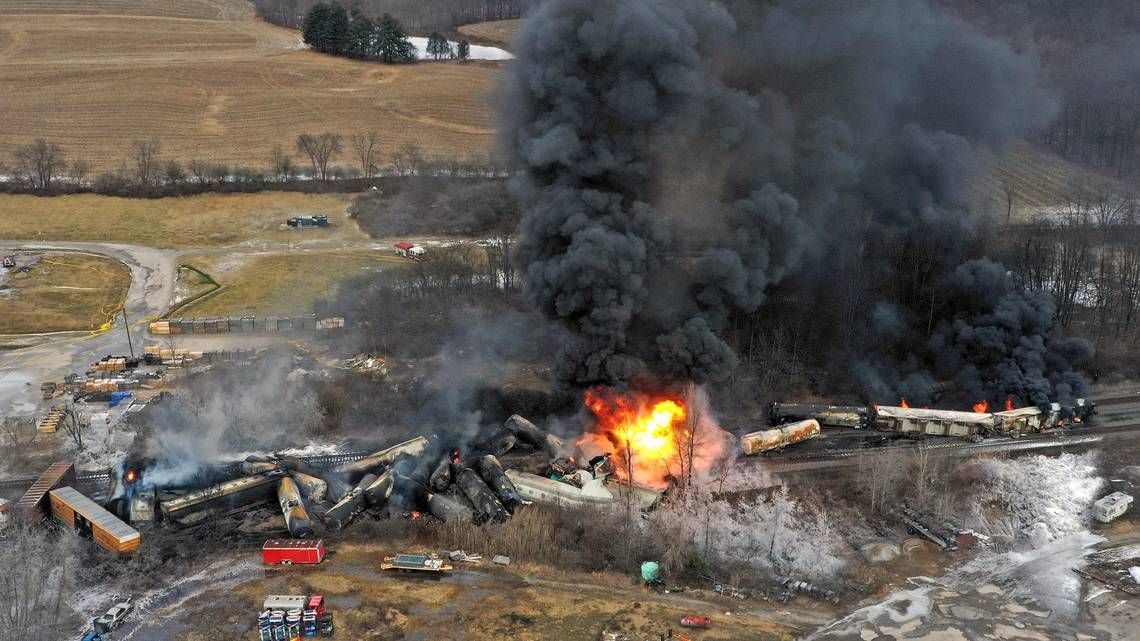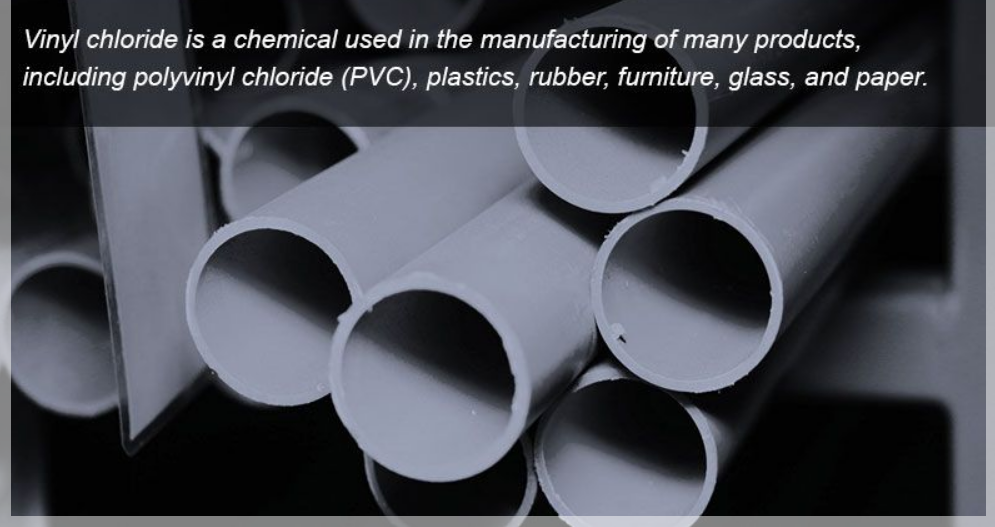Vinyl chloride
Vinyl chloride is a chemical used in the manufacturing of many products, including polyvinyl chloride (PVC), plastics, rubber, furniture, glass, and paper. It is also used in automobile manufacturing and in construction.
This chemical compound has been identified as a human carcinogen, and long-term vinyl chloride exposure can lead to liver cancer, leukemia and brain cancer.
There are a number of ways in which a person can become exposed to vinyl chloride, including through:
- Inhalation
- Drinking contaminated water
- Work - people who work with vinyl chloride are at the highest risk of vinyl chloride exposure
- Environmental incidents (including wildfires, explosions, train derailments, etc.)
People who work in the following industries, in particular, should be aware of this risk:
- PVC manufacturing
- Automobile
- Construction
- Furniture
- Plastics manufacturing
- Rubber manufacturing
First responders also need to provided with training on how to properly assess and handle situations where dangerous chemicals are involved and how to protect themselves and others in the area.
Residents living near chemical release incidents face potential exposure to these contaminants through various pathways, including air inhalation, soil ingestion, dermal contact, consumption of food grown or generated in the affected areas (e.g., vegetables, meat, and dairy), and drinking water.
Health Effects of Vinyl Chloride
Long-term vinyl chloride exposure can lead to several adverse health conditions and diseases, including:
- Liver cancer - angiosarcoma of the liver is one of the most common side effects of vinyl chloride exposure
- Liver disease - results in liver tissue damage and may require a transplant
- Leukemia
- Brain cancer
- Raynaud's syndrome - a condition in which blood flow to the fingers and toes is inhibited
Identifying long-term health risks associated with environmental chemical incidents
We are witnessing a notable surge in environmental crises, including wildfires that extend beyond forests to impact populated areas and associated structures, and an increasing prevalence of man-made environmental incidents, such as chemical release incidents.
According to a chemical disaster tracker (https://preventchemicaldisasters.org), chemical accidents occurred almost every day in 2023 in the United States (U.S.), including several major incidents, such as:
- a chemical plant fire in La Salle, Illinois (January 2023),
- massive fires at recycling centers in eastern Indiana (April 2023), Philadelphia, Pennsylvania (May 2023), and Brockton, Massachusetts (August 2023),
- and a chemical plant explosion in Texas (November 2023).
Adding to these concerns, the derailment of a freight train in East Palestine, Ohio on February 3, 2023, while transporting hazardous chemicals, serves as a stark reminder of the vulnerabilities of affected communities and the environment.
These environmental crises potentially pose both immediate and long-term risks to first responders, workers, and communities.
Responses to such events have primarily focused on addressing acute and immediate impacts. However, potential long-term health risks have been overlooked.
Our proposed framework first advocates for the holistic identification of contaminants, prioritizing persistent organic contaminants determined through both knowledge-based and non-targeted and targeted analysis.
We suggest integrating environmental monitoring and modeling approaches to assess the extent and composition of contamination caused by these chemicals.
To facilitate swift assessments, we advocate the development of streamlined chemical analysis techniques and dedicated technologies for in situ monitoring of persistent organic chemicals.
In addition, we provide an overview of both traditional and state-of-the-art approaches to risk assessment and introduce a three-tier risk assessment framework for evaluating the long-term health risks associated with environmental incidents.
We emphasize the importance of in situ soil remediation and coordinated recovery efforts, including effective communication, evacuation, and cleaning plans for affected spaces, which are pivotal for facilitating recovery from environmental incidents.
Read the research paper.

Vinyl chloride is a human carcinogen that can cause liver cancer, leukemia and cancer. It was released into the air after a train derailment in East Palestine, Ohio, on February 3, 2023.

Vinyl chloride is used to manufacture plastics, rubber, furniture, glass and paper and is also used in automobile manufacturing and construction.
Human Health Risk following the East Palestine, Ohio, Train Derailment (2023)
On February 3, 2023, a train carrying numerous hazardous chemicals derailed in East Palestine, OH, spurring temporary evacuation of residents and a controlled burn of some of the hazardous cargo.
Reports of symptoms in East Palestine indicated a portion of the population experienced headaches, nausea, cough, bloody noses, and respiratory, skin, and eye irritation.
Initial data from U.S. Environmental Protection Agency (EPA) stationary air monitors indicated levels of potential concern for air toxics based on hazard quotient calculations. To provide complementary data, we conducted mobile air quality sampling on February 20 and 21 using proton transfer reaction-mass spectrometry.
Levels of acrolein were high relative to those of other volatile organic compounds, with spatial analyses showing levels in East Palestine up to 6 times higher than the local rural background. Nontargeted analyses identified levels of additional unique compounds above background levels, some displaying spatiotemporal patterns similar to that of acrolein and others exhibiting distinct hot spots.
Acrolein is a common combustion product and a known respiratory irritant. Breathing low levels is linked with eye watering, burning of the nose and throat, and decreased breathing rates. Experimental studies show inhala-
tion causes irritation of the nasal cavity, decreased breathing rates, and damage to the lining of the lung, as well as pathological lesions and nasal tumors with long-term chronic exposure.
Our nontargeted mobile sampling found numerous other chemicals with increased levels in East Palestine compared to the local rural background. A number of these compounds have also been linked to respiratory effects. For instance, exposure to formamide has been linked with irritation of the eyes and skin, drowsiness, and nausea, and methyl formate exposure has been linked with numerous symptoms, including irritation of the eyes and nose, chest tightness, dyspnea, and central nervous system depression. Several other compounds exhibited distinct hot spot patterns with peaks ≤10 times above the background.
These initial findings support the need for continued mobile monitoring to characterize the air quality impacts of the East Palestine train derailment, especially as cleanup activities may result in resuspension and revolatilization of contaminants from the soil.
More broadly, this study illustrates that the ability of highly sensitive, nontargeted mobile monitoring to detect known and unknown VOCs can serve as a complement to the targeted and stationary monitoring typically deployed, facilitating characterization of the impacts of disasters on air
quality and ultimately better protecting public health.
Read the research paper.
Activism by Families Affected by Environmental Disasters
According to the Environmental Protection Agency (EPA), dozens of cars containing toxic chemicals like vinyl chloride, ethylene glycol, ethylhexyl acrylate, butyl acrylate and isobutylene derailed (in East Palestine, Ohio).
Some of the chemicals ended up contaminating nearby streams, killing thousands of fish. Other chemicals ignited into flames that wouldn't go out.
The local fire department decided to conduct a controlled burn of the remaining chemicals days after the incident--fearful that if they didn't it could lead to a larger explosion, further endangering residents.
"When authorities conducted a controlled burn, it was like a bomb went off, a bomb containing vinyl chloride, which releases dangerous chemicals."
Misti Allison (a resident of East Palestine, Ohio) is following in the tradition of women before her who have been galvanized to take action when an environmental health disaster threatens their towns and families.
Phil Brown, a professor of sociology and health sciences at Northeastern University who has written books on toxic waste activism, said women, and mothers in particular, have consistently organized locally after incidents like the Ohio train derailment.
In Woburn, Massachusetts, where a leukemia cluster was linked to an industrial chemical spill in the Aberjona River in the late 1970s, it was mothers who were talking at the pediatric oncology center south of Boston, connecting the dots between their children’s leukemia and contaminated water wells, he said.
Around the same time, housewife Lois Gibbs was investigating the root cause of mysterious illnesses that had been popping up in her community, including in her own children. She discovered that her neighborhood was situated atop over 21,000 tons of buried chemical waste. Gibbs, who went on to found the Center for Health, Environment and Justice, is credited with helping lead the creation of the EPAs Superfund Program, which focused on cleaning up contaminated sites around the country.
Read the article.